Analyzing Authentic Leadership, Leader-Member Exchange, and PsyCap
VerifiedAdded on 2021/12/09
|12
|2997
|332
Essay
AI Summary
This essay examines the intricate relationship between authentic leadership, leader-member exchange (LMX), and employee psychological capital (PsyCap). It reviews existing literature highlighting how authentic leadership and positive work environments enhance employee PsyCap, leading to increased creativity and improved attitudes. The essay further discusses methods for building psychological capital in employees through interventions like training programs and the cultivation of positive leader-follower relationships. It emphasizes the significant impact of workplace emotions on employee performance, decision-making, and overall job satisfaction, noting how positive emotions foster motivation and productivity, while negative emotions can lead to decreased performance and increased turnover. The role of workplace education programs in enhancing employee skills and reducing turnover is also explored, underscoring the importance of a supportive and respectful work environment.
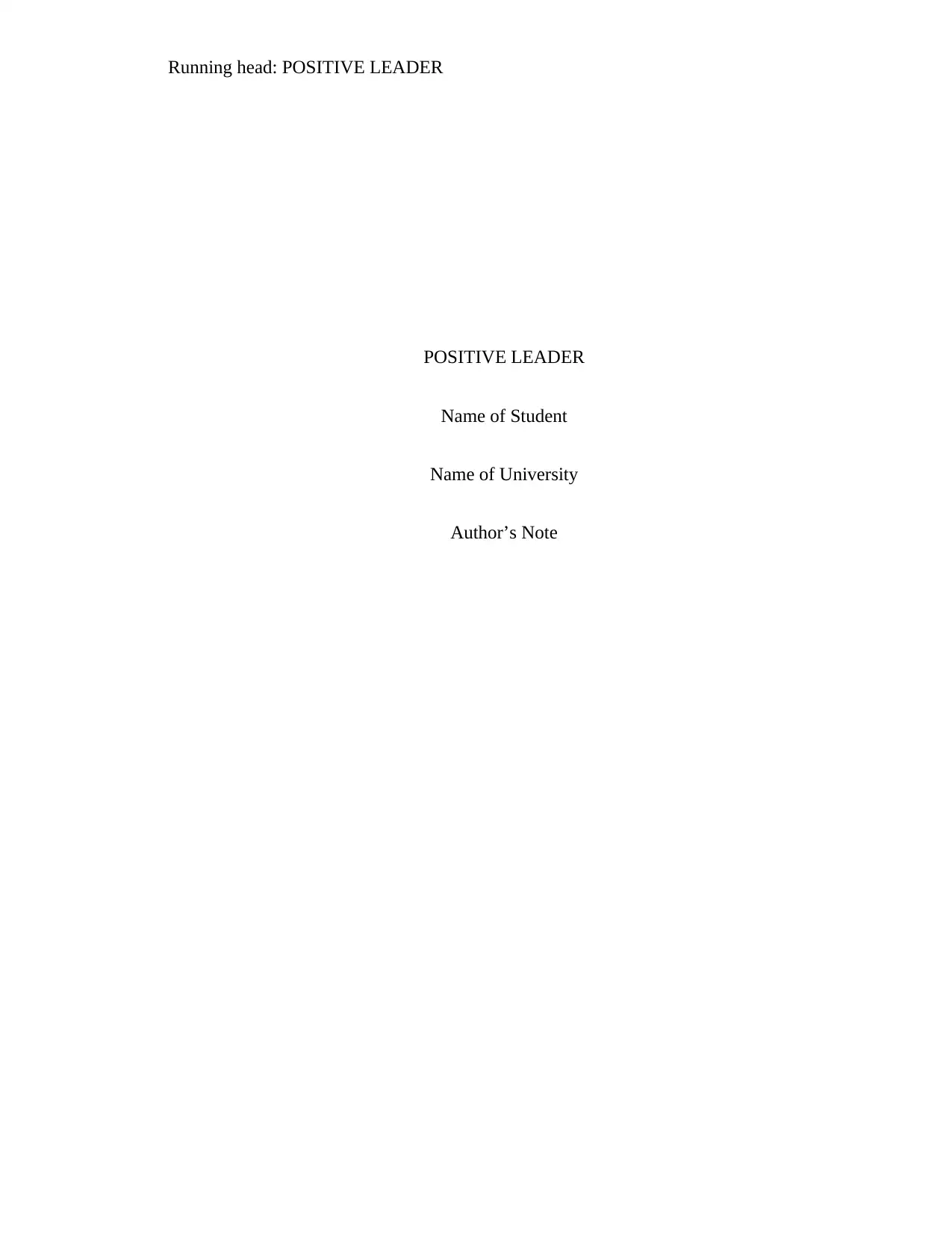
Running head: POSITIVE LEADER
POSITIVE LEADER
Name of Student
Name of University
Author’s Note
POSITIVE LEADER
Name of Student
Name of University
Author’s Note
Paraphrase This Document
Need a fresh take? Get an instant paraphrase of this document with our AI Paraphraser
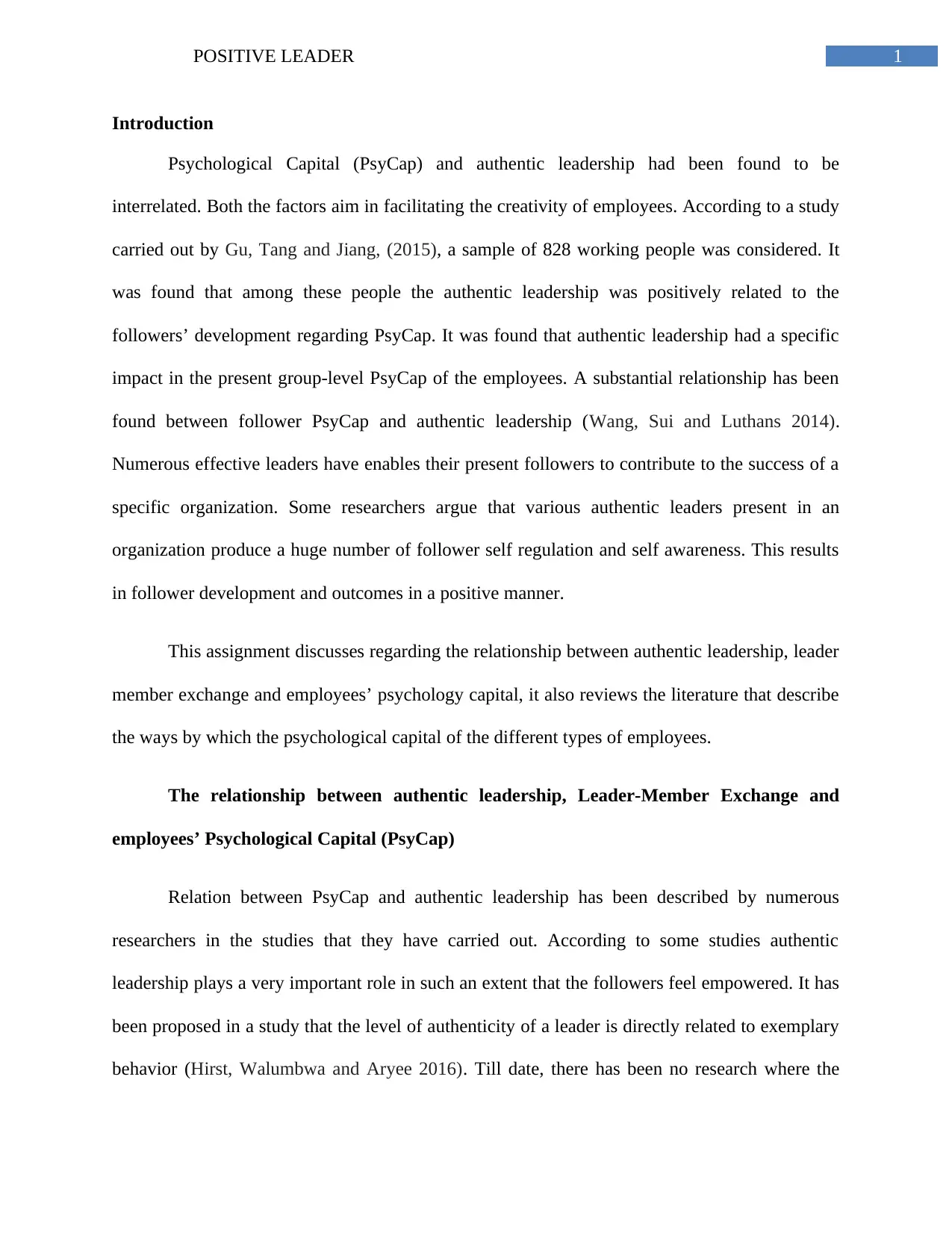
1POSITIVE LEADER
Introduction
Psychological Capital (PsyCap) and authentic leadership had been found to be
interrelated. Both the factors aim in facilitating the creativity of employees. According to a study
carried out by Gu, Tang and Jiang, (2015), a sample of 828 working people was considered. It
was found that among these people the authentic leadership was positively related to the
followers’ development regarding PsyCap. It was found that authentic leadership had a specific
impact in the present group-level PsyCap of the employees. A substantial relationship has been
found between follower PsyCap and authentic leadership (Wang, Sui and Luthans 2014).
Numerous effective leaders have enables their present followers to contribute to the success of a
specific organization. Some researchers argue that various authentic leaders present in an
organization produce a huge number of follower self regulation and self awareness. This results
in follower development and outcomes in a positive manner.
This assignment discusses regarding the relationship between authentic leadership, leader
member exchange and employees’ psychology capital, it also reviews the literature that describe
the ways by which the psychological capital of the different types of employees.
The relationship between authentic leadership, Leader-Member Exchange and
employees’ Psychological Capital (PsyCap)
Relation between PsyCap and authentic leadership has been described by numerous
researchers in the studies that they have carried out. According to some studies authentic
leadership plays a very important role in such an extent that the followers feel empowered. It has
been proposed in a study that the level of authenticity of a leader is directly related to exemplary
behavior (Hirst, Walumbwa and Aryee 2016). Till date, there has been no research where the
Introduction
Psychological Capital (PsyCap) and authentic leadership had been found to be
interrelated. Both the factors aim in facilitating the creativity of employees. According to a study
carried out by Gu, Tang and Jiang, (2015), a sample of 828 working people was considered. It
was found that among these people the authentic leadership was positively related to the
followers’ development regarding PsyCap. It was found that authentic leadership had a specific
impact in the present group-level PsyCap of the employees. A substantial relationship has been
found between follower PsyCap and authentic leadership (Wang, Sui and Luthans 2014).
Numerous effective leaders have enables their present followers to contribute to the success of a
specific organization. Some researchers argue that various authentic leaders present in an
organization produce a huge number of follower self regulation and self awareness. This results
in follower development and outcomes in a positive manner.
This assignment discusses regarding the relationship between authentic leadership, leader
member exchange and employees’ psychology capital, it also reviews the literature that describe
the ways by which the psychological capital of the different types of employees.
The relationship between authentic leadership, Leader-Member Exchange and
employees’ Psychological Capital (PsyCap)
Relation between PsyCap and authentic leadership has been described by numerous
researchers in the studies that they have carried out. According to some studies authentic
leadership plays a very important role in such an extent that the followers feel empowered. It has
been proposed in a study that the level of authenticity of a leader is directly related to exemplary
behavior (Hirst, Walumbwa and Aryee 2016). Till date, there has been no research where the
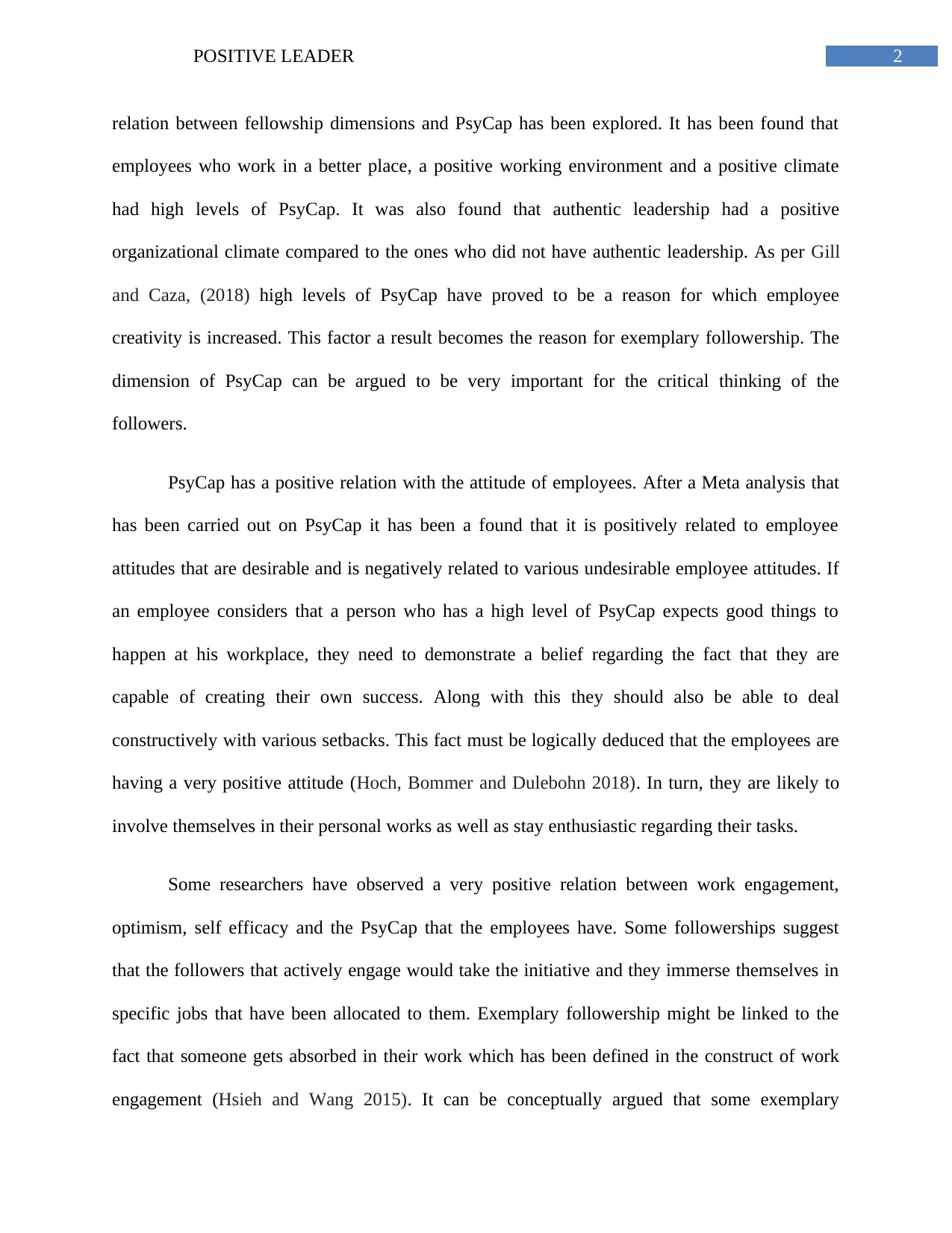
2POSITIVE LEADER
relation between fellowship dimensions and PsyCap has been explored. It has been found that
employees who work in a better place, a positive working environment and a positive climate
had high levels of PsyCap. It was also found that authentic leadership had a positive
organizational climate compared to the ones who did not have authentic leadership. As per Gill
and Caza, (2018) high levels of PsyCap have proved to be a reason for which employee
creativity is increased. This factor a result becomes the reason for exemplary followership. The
dimension of PsyCap can be argued to be very important for the critical thinking of the
followers.
PsyCap has a positive relation with the attitude of employees. After a Meta analysis that
has been carried out on PsyCap it has been a found that it is positively related to employee
attitudes that are desirable and is negatively related to various undesirable employee attitudes. If
an employee considers that a person who has a high level of PsyCap expects good things to
happen at his workplace, they need to demonstrate a belief regarding the fact that they are
capable of creating their own success. Along with this they should also be able to deal
constructively with various setbacks. This fact must be logically deduced that the employees are
having a very positive attitude (Hoch, Bommer and Dulebohn 2018). In turn, they are likely to
involve themselves in their personal works as well as stay enthusiastic regarding their tasks.
Some researchers have observed a very positive relation between work engagement,
optimism, self efficacy and the PsyCap that the employees have. Some followerships suggest
that the followers that actively engage would take the initiative and they immerse themselves in
specific jobs that have been allocated to them. Exemplary followership might be linked to the
fact that someone gets absorbed in their work which has been defined in the construct of work
engagement (Hsieh and Wang 2015). It can be conceptually argued that some exemplary
relation between fellowship dimensions and PsyCap has been explored. It has been found that
employees who work in a better place, a positive working environment and a positive climate
had high levels of PsyCap. It was also found that authentic leadership had a positive
organizational climate compared to the ones who did not have authentic leadership. As per Gill
and Caza, (2018) high levels of PsyCap have proved to be a reason for which employee
creativity is increased. This factor a result becomes the reason for exemplary followership. The
dimension of PsyCap can be argued to be very important for the critical thinking of the
followers.
PsyCap has a positive relation with the attitude of employees. After a Meta analysis that
has been carried out on PsyCap it has been a found that it is positively related to employee
attitudes that are desirable and is negatively related to various undesirable employee attitudes. If
an employee considers that a person who has a high level of PsyCap expects good things to
happen at his workplace, they need to demonstrate a belief regarding the fact that they are
capable of creating their own success. Along with this they should also be able to deal
constructively with various setbacks. This fact must be logically deduced that the employees are
having a very positive attitude (Hoch, Bommer and Dulebohn 2018). In turn, they are likely to
involve themselves in their personal works as well as stay enthusiastic regarding their tasks.
Some researchers have observed a very positive relation between work engagement,
optimism, self efficacy and the PsyCap that the employees have. Some followerships suggest
that the followers that actively engage would take the initiative and they immerse themselves in
specific jobs that have been allocated to them. Exemplary followership might be linked to the
fact that someone gets absorbed in their work which has been defined in the construct of work
engagement (Hsieh and Wang 2015). It can be conceptually argued that some exemplary
⊘ This is a preview!⊘
Do you want full access?
Subscribe today to unlock all pages.

Trusted by 1+ million students worldwide
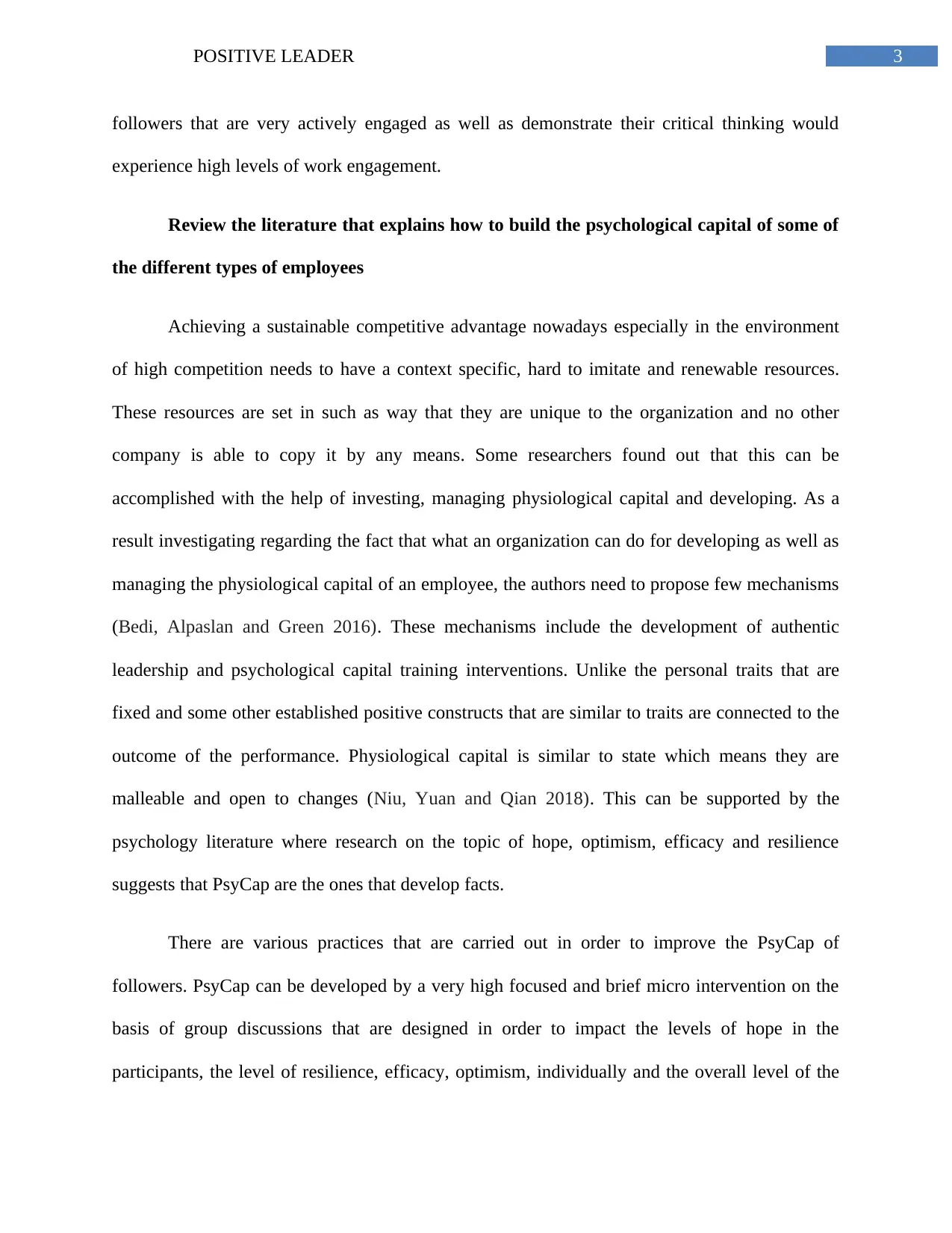
3POSITIVE LEADER
followers that are very actively engaged as well as demonstrate their critical thinking would
experience high levels of work engagement.
Review the literature that explains how to build the psychological capital of some of
the different types of employees
Achieving a sustainable competitive advantage nowadays especially in the environment
of high competition needs to have a context specific, hard to imitate and renewable resources.
These resources are set in such as way that they are unique to the organization and no other
company is able to copy it by any means. Some researchers found out that this can be
accomplished with the help of investing, managing physiological capital and developing. As a
result investigating regarding the fact that what an organization can do for developing as well as
managing the physiological capital of an employee, the authors need to propose few mechanisms
(Bedi, Alpaslan and Green 2016). These mechanisms include the development of authentic
leadership and psychological capital training interventions. Unlike the personal traits that are
fixed and some other established positive constructs that are similar to traits are connected to the
outcome of the performance. Physiological capital is similar to state which means they are
malleable and open to changes (Niu, Yuan and Qian 2018). This can be supported by the
psychology literature where research on the topic of hope, optimism, efficacy and resilience
suggests that PsyCap are the ones that develop facts.
There are various practices that are carried out in order to improve the PsyCap of
followers. PsyCap can be developed by a very high focused and brief micro intervention on the
basis of group discussions that are designed in order to impact the levels of hope in the
participants, the level of resilience, efficacy, optimism, individually and the overall level of the
followers that are very actively engaged as well as demonstrate their critical thinking would
experience high levels of work engagement.
Review the literature that explains how to build the psychological capital of some of
the different types of employees
Achieving a sustainable competitive advantage nowadays especially in the environment
of high competition needs to have a context specific, hard to imitate and renewable resources.
These resources are set in such as way that they are unique to the organization and no other
company is able to copy it by any means. Some researchers found out that this can be
accomplished with the help of investing, managing physiological capital and developing. As a
result investigating regarding the fact that what an organization can do for developing as well as
managing the physiological capital of an employee, the authors need to propose few mechanisms
(Bedi, Alpaslan and Green 2016). These mechanisms include the development of authentic
leadership and psychological capital training interventions. Unlike the personal traits that are
fixed and some other established positive constructs that are similar to traits are connected to the
outcome of the performance. Physiological capital is similar to state which means they are
malleable and open to changes (Niu, Yuan and Qian 2018). This can be supported by the
psychology literature where research on the topic of hope, optimism, efficacy and resilience
suggests that PsyCap are the ones that develop facts.
There are various practices that are carried out in order to improve the PsyCap of
followers. PsyCap can be developed by a very high focused and brief micro intervention on the
basis of group discussions that are designed in order to impact the levels of hope in the
participants, the level of resilience, efficacy, optimism, individually and the overall level of the
Paraphrase This Document
Need a fresh take? Get an instant paraphrase of this document with our AI Paraphraser
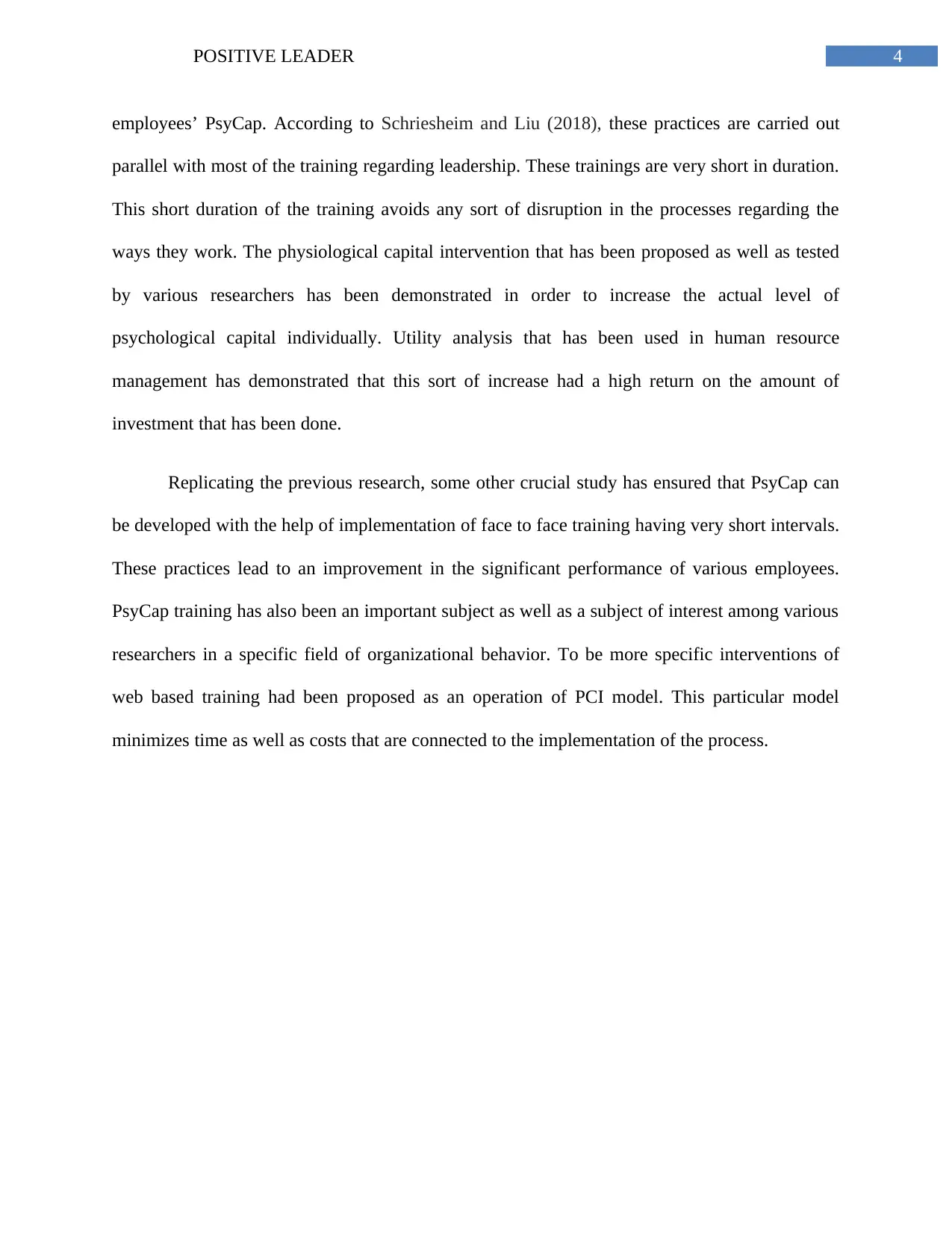
4POSITIVE LEADER
employees’ PsyCap. According to Schriesheim and Liu (2018), these practices are carried out
parallel with most of the training regarding leadership. These trainings are very short in duration.
This short duration of the training avoids any sort of disruption in the processes regarding the
ways they work. The physiological capital intervention that has been proposed as well as tested
by various researchers has been demonstrated in order to increase the actual level of
psychological capital individually. Utility analysis that has been used in human resource
management has demonstrated that this sort of increase had a high return on the amount of
investment that has been done.
Replicating the previous research, some other crucial study has ensured that PsyCap can
be developed with the help of implementation of face to face training having very short intervals.
These practices lead to an improvement in the significant performance of various employees.
PsyCap training has also been an important subject as well as a subject of interest among various
researchers in a specific field of organizational behavior. To be more specific interventions of
web based training had been proposed as an operation of PCI model. This particular model
minimizes time as well as costs that are connected to the implementation of the process.
employees’ PsyCap. According to Schriesheim and Liu (2018), these practices are carried out
parallel with most of the training regarding leadership. These trainings are very short in duration.
This short duration of the training avoids any sort of disruption in the processes regarding the
ways they work. The physiological capital intervention that has been proposed as well as tested
by various researchers has been demonstrated in order to increase the actual level of
psychological capital individually. Utility analysis that has been used in human resource
management has demonstrated that this sort of increase had a high return on the amount of
investment that has been done.
Replicating the previous research, some other crucial study has ensured that PsyCap can
be developed with the help of implementation of face to face training having very short intervals.
These practices lead to an improvement in the significant performance of various employees.
PsyCap training has also been an important subject as well as a subject of interest among various
researchers in a specific field of organizational behavior. To be more specific interventions of
web based training had been proposed as an operation of PCI model. This particular model
minimizes time as well as costs that are connected to the implementation of the process.
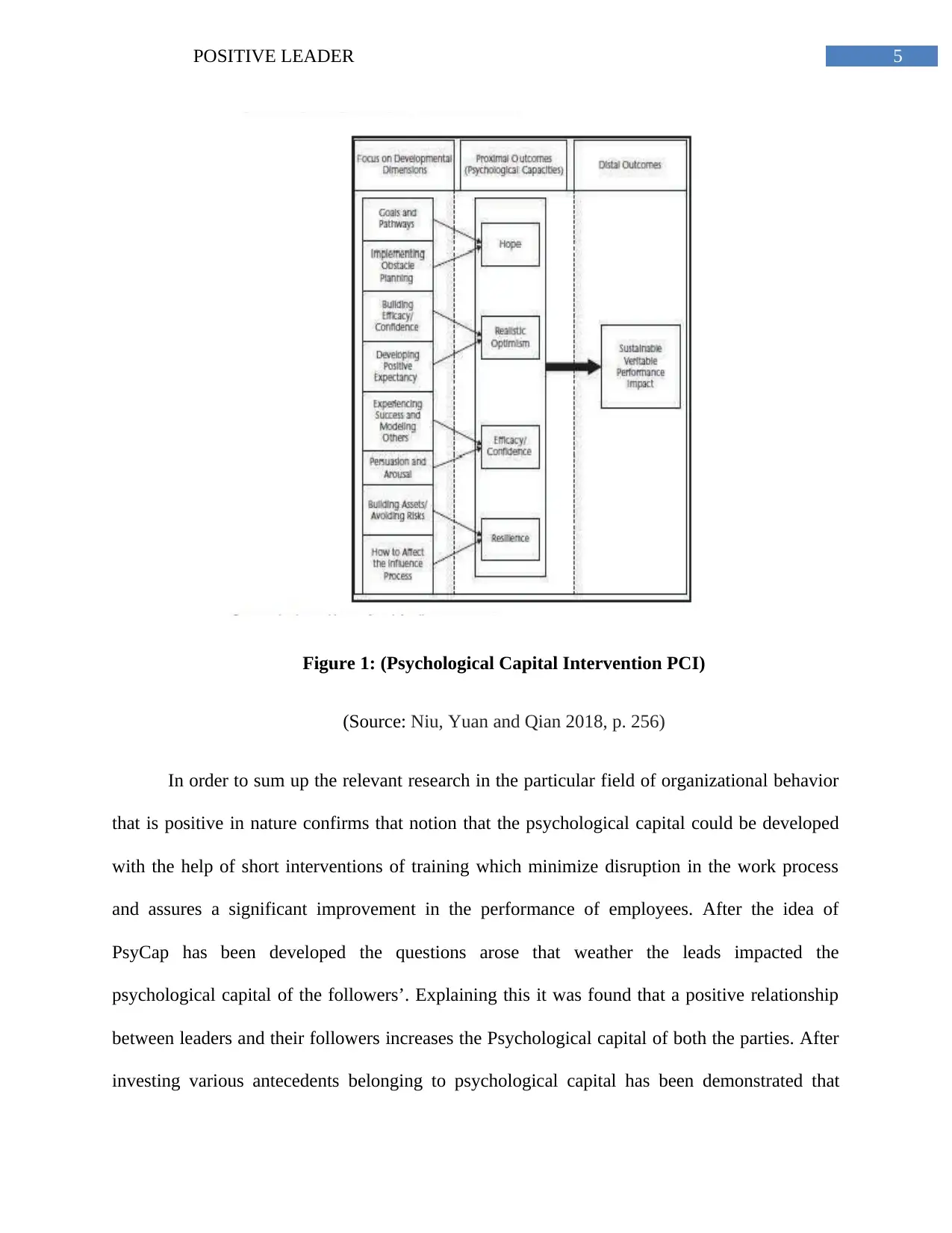
5POSITIVE LEADER
Figure 1: (Psychological Capital Intervention PCI)
(Source: Niu, Yuan and Qian 2018, p. 256)
In order to sum up the relevant research in the particular field of organizational behavior
that is positive in nature confirms that notion that the psychological capital could be developed
with the help of short interventions of training which minimize disruption in the work process
and assures a significant improvement in the performance of employees. After the idea of
PsyCap has been developed the questions arose that weather the leads impacted the
psychological capital of the followers’. Explaining this it was found that a positive relationship
between leaders and their followers increases the Psychological capital of both the parties. After
investing various antecedents belonging to psychological capital has been demonstrated that
Figure 1: (Psychological Capital Intervention PCI)
(Source: Niu, Yuan and Qian 2018, p. 256)
In order to sum up the relevant research in the particular field of organizational behavior
that is positive in nature confirms that notion that the psychological capital could be developed
with the help of short interventions of training which minimize disruption in the work process
and assures a significant improvement in the performance of employees. After the idea of
PsyCap has been developed the questions arose that weather the leads impacted the
psychological capital of the followers’. Explaining this it was found that a positive relationship
between leaders and their followers increases the Psychological capital of both the parties. After
investing various antecedents belonging to psychological capital has been demonstrated that
⊘ This is a preview!⊘
Do you want full access?
Subscribe today to unlock all pages.

Trusted by 1+ million students worldwide
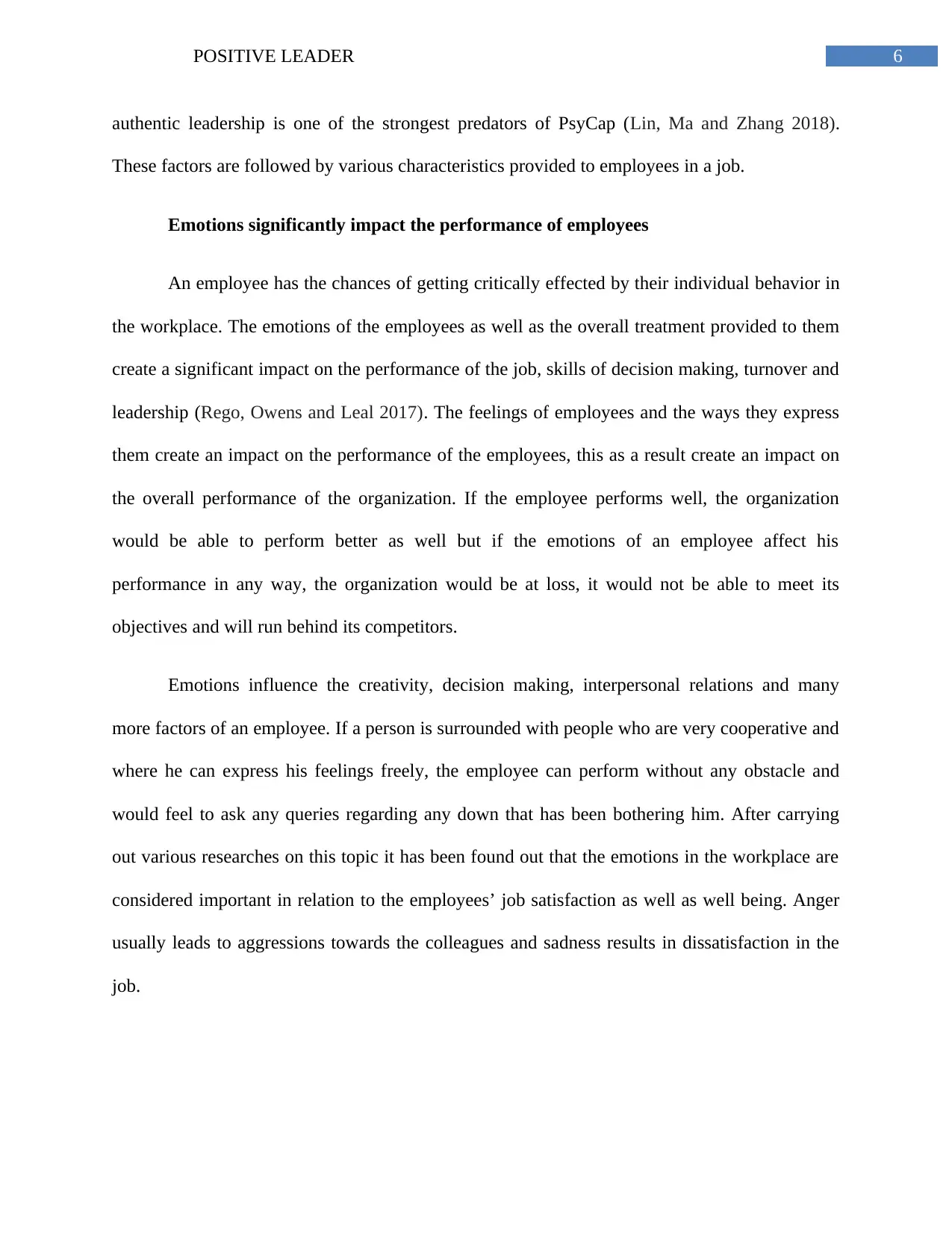
6POSITIVE LEADER
authentic leadership is one of the strongest predators of PsyCap (Lin, Ma and Zhang 2018).
These factors are followed by various characteristics provided to employees in a job.
Emotions significantly impact the performance of employees
An employee has the chances of getting critically effected by their individual behavior in
the workplace. The emotions of the employees as well as the overall treatment provided to them
create a significant impact on the performance of the job, skills of decision making, turnover and
leadership (Rego, Owens and Leal 2017). The feelings of employees and the ways they express
them create an impact on the performance of the employees, this as a result create an impact on
the overall performance of the organization. If the employee performs well, the organization
would be able to perform better as well but if the emotions of an employee affect his
performance in any way, the organization would be at loss, it would not be able to meet its
objectives and will run behind its competitors.
Emotions influence the creativity, decision making, interpersonal relations and many
more factors of an employee. If a person is surrounded with people who are very cooperative and
where he can express his feelings freely, the employee can perform without any obstacle and
would feel to ask any queries regarding any down that has been bothering him. After carrying
out various researches on this topic it has been found out that the emotions in the workplace are
considered important in relation to the employees’ job satisfaction as well as well being. Anger
usually leads to aggressions towards the colleagues and sadness results in dissatisfaction in the
job.
authentic leadership is one of the strongest predators of PsyCap (Lin, Ma and Zhang 2018).
These factors are followed by various characteristics provided to employees in a job.
Emotions significantly impact the performance of employees
An employee has the chances of getting critically effected by their individual behavior in
the workplace. The emotions of the employees as well as the overall treatment provided to them
create a significant impact on the performance of the job, skills of decision making, turnover and
leadership (Rego, Owens and Leal 2017). The feelings of employees and the ways they express
them create an impact on the performance of the employees, this as a result create an impact on
the overall performance of the organization. If the employee performs well, the organization
would be able to perform better as well but if the emotions of an employee affect his
performance in any way, the organization would be at loss, it would not be able to meet its
objectives and will run behind its competitors.
Emotions influence the creativity, decision making, interpersonal relations and many
more factors of an employee. If a person is surrounded with people who are very cooperative and
where he can express his feelings freely, the employee can perform without any obstacle and
would feel to ask any queries regarding any down that has been bothering him. After carrying
out various researches on this topic it has been found out that the emotions in the workplace are
considered important in relation to the employees’ job satisfaction as well as well being. Anger
usually leads to aggressions towards the colleagues and sadness results in dissatisfaction in the
job.
Paraphrase This Document
Need a fresh take? Get an instant paraphrase of this document with our AI Paraphraser
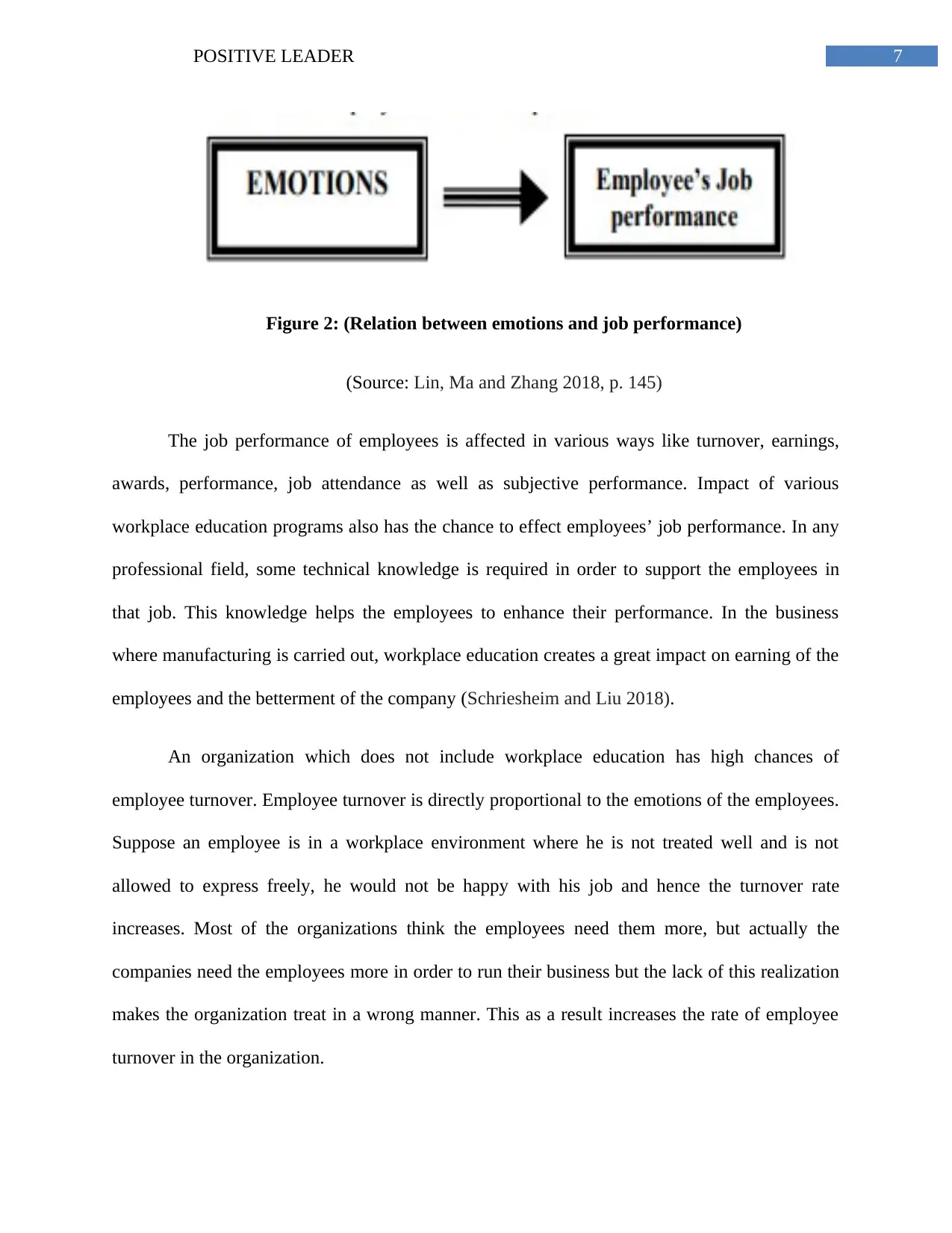
7POSITIVE LEADER
Figure 2: (Relation between emotions and job performance)
(Source: Lin, Ma and Zhang 2018, p. 145)
The job performance of employees is affected in various ways like turnover, earnings,
awards, performance, job attendance as well as subjective performance. Impact of various
workplace education programs also has the chance to effect employees’ job performance. In any
professional field, some technical knowledge is required in order to support the employees in
that job. This knowledge helps the employees to enhance their performance. In the business
where manufacturing is carried out, workplace education creates a great impact on earning of the
employees and the betterment of the company (Schriesheim and Liu 2018).
An organization which does not include workplace education has high chances of
employee turnover. Employee turnover is directly proportional to the emotions of the employees.
Suppose an employee is in a workplace environment where he is not treated well and is not
allowed to express freely, he would not be happy with his job and hence the turnover rate
increases. Most of the organizations think the employees need them more, but actually the
companies need the employees more in order to run their business but the lack of this realization
makes the organization treat in a wrong manner. This as a result increases the rate of employee
turnover in the organization.
Figure 2: (Relation between emotions and job performance)
(Source: Lin, Ma and Zhang 2018, p. 145)
The job performance of employees is affected in various ways like turnover, earnings,
awards, performance, job attendance as well as subjective performance. Impact of various
workplace education programs also has the chance to effect employees’ job performance. In any
professional field, some technical knowledge is required in order to support the employees in
that job. This knowledge helps the employees to enhance their performance. In the business
where manufacturing is carried out, workplace education creates a great impact on earning of the
employees and the betterment of the company (Schriesheim and Liu 2018).
An organization which does not include workplace education has high chances of
employee turnover. Employee turnover is directly proportional to the emotions of the employees.
Suppose an employee is in a workplace environment where he is not treated well and is not
allowed to express freely, he would not be happy with his job and hence the turnover rate
increases. Most of the organizations think the employees need them more, but actually the
companies need the employees more in order to run their business but the lack of this realization
makes the organization treat in a wrong manner. This as a result increases the rate of employee
turnover in the organization.
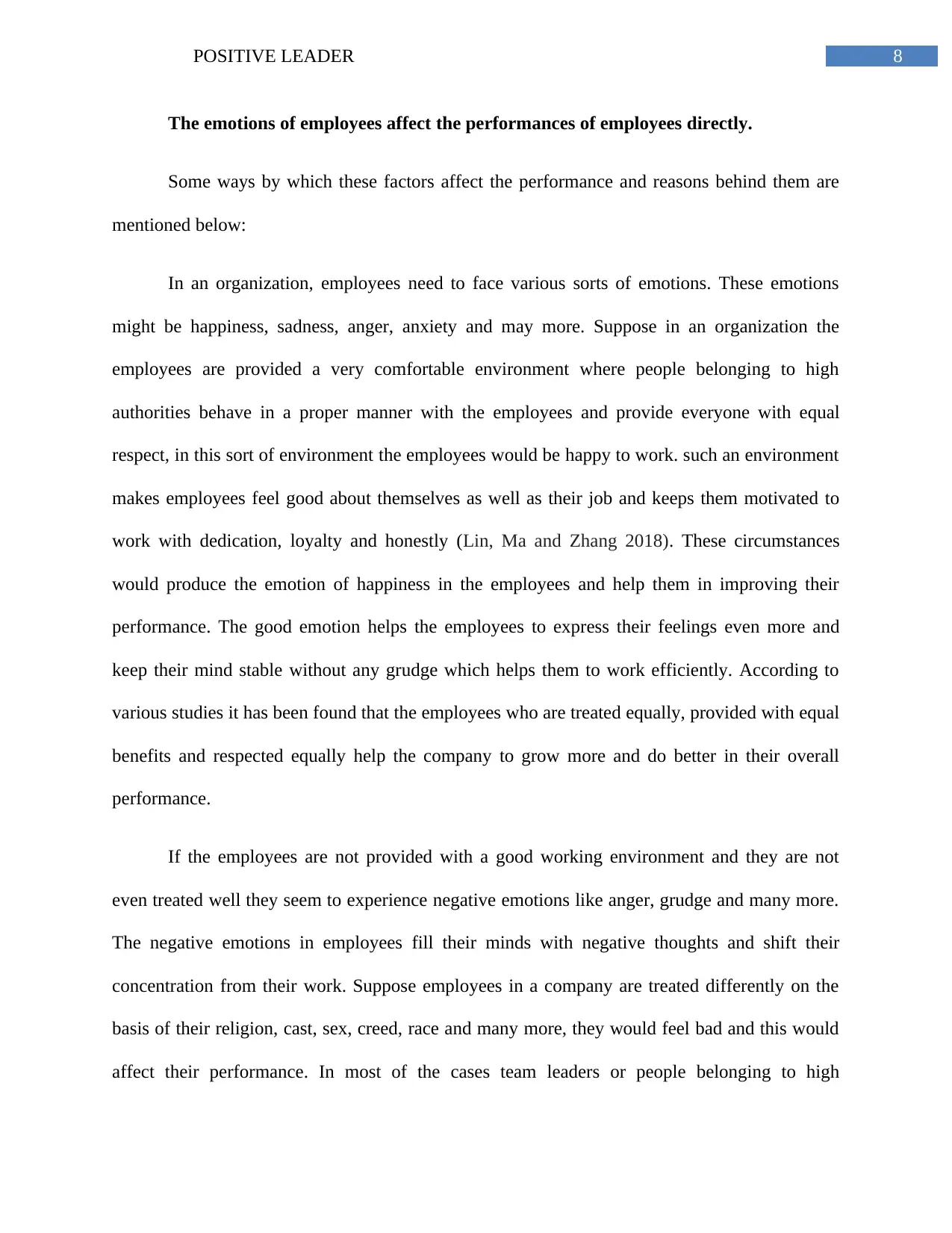
8POSITIVE LEADER
The emotions of employees affect the performances of employees directly.
Some ways by which these factors affect the performance and reasons behind them are
mentioned below:
In an organization, employees need to face various sorts of emotions. These emotions
might be happiness, sadness, anger, anxiety and may more. Suppose in an organization the
employees are provided a very comfortable environment where people belonging to high
authorities behave in a proper manner with the employees and provide everyone with equal
respect, in this sort of environment the employees would be happy to work. such an environment
makes employees feel good about themselves as well as their job and keeps them motivated to
work with dedication, loyalty and honestly (Lin, Ma and Zhang 2018). These circumstances
would produce the emotion of happiness in the employees and help them in improving their
performance. The good emotion helps the employees to express their feelings even more and
keep their mind stable without any grudge which helps them to work efficiently. According to
various studies it has been found that the employees who are treated equally, provided with equal
benefits and respected equally help the company to grow more and do better in their overall
performance.
If the employees are not provided with a good working environment and they are not
even treated well they seem to experience negative emotions like anger, grudge and many more.
The negative emotions in employees fill their minds with negative thoughts and shift their
concentration from their work. Suppose employees in a company are treated differently on the
basis of their religion, cast, sex, creed, race and many more, they would feel bad and this would
affect their performance. In most of the cases team leaders or people belonging to high
The emotions of employees affect the performances of employees directly.
Some ways by which these factors affect the performance and reasons behind them are
mentioned below:
In an organization, employees need to face various sorts of emotions. These emotions
might be happiness, sadness, anger, anxiety and may more. Suppose in an organization the
employees are provided a very comfortable environment where people belonging to high
authorities behave in a proper manner with the employees and provide everyone with equal
respect, in this sort of environment the employees would be happy to work. such an environment
makes employees feel good about themselves as well as their job and keeps them motivated to
work with dedication, loyalty and honestly (Lin, Ma and Zhang 2018). These circumstances
would produce the emotion of happiness in the employees and help them in improving their
performance. The good emotion helps the employees to express their feelings even more and
keep their mind stable without any grudge which helps them to work efficiently. According to
various studies it has been found that the employees who are treated equally, provided with equal
benefits and respected equally help the company to grow more and do better in their overall
performance.
If the employees are not provided with a good working environment and they are not
even treated well they seem to experience negative emotions like anger, grudge and many more.
The negative emotions in employees fill their minds with negative thoughts and shift their
concentration from their work. Suppose employees in a company are treated differently on the
basis of their religion, cast, sex, creed, race and many more, they would feel bad and this would
affect their performance. In most of the cases team leaders or people belonging to high
⊘ This is a preview!⊘
Do you want full access?
Subscribe today to unlock all pages.

Trusted by 1+ million students worldwide
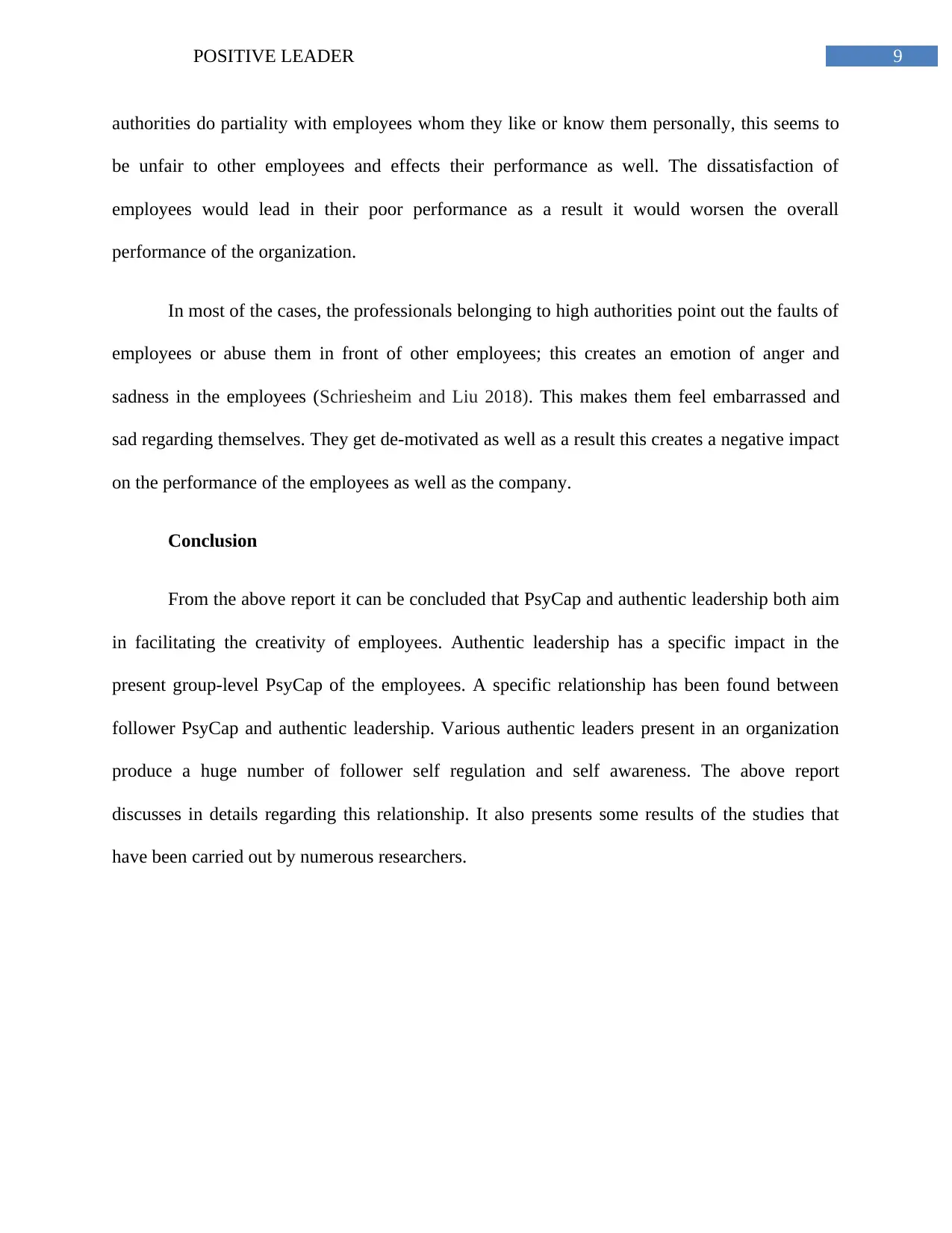
9POSITIVE LEADER
authorities do partiality with employees whom they like or know them personally, this seems to
be unfair to other employees and effects their performance as well. The dissatisfaction of
employees would lead in their poor performance as a result it would worsen the overall
performance of the organization.
In most of the cases, the professionals belonging to high authorities point out the faults of
employees or abuse them in front of other employees; this creates an emotion of anger and
sadness in the employees (Schriesheim and Liu 2018). This makes them feel embarrassed and
sad regarding themselves. They get de-motivated as well as a result this creates a negative impact
on the performance of the employees as well as the company.
Conclusion
From the above report it can be concluded that PsyCap and authentic leadership both aim
in facilitating the creativity of employees. Authentic leadership has a specific impact in the
present group-level PsyCap of the employees. A specific relationship has been found between
follower PsyCap and authentic leadership. Various authentic leaders present in an organization
produce a huge number of follower self regulation and self awareness. The above report
discusses in details regarding this relationship. It also presents some results of the studies that
have been carried out by numerous researchers.
authorities do partiality with employees whom they like or know them personally, this seems to
be unfair to other employees and effects their performance as well. The dissatisfaction of
employees would lead in their poor performance as a result it would worsen the overall
performance of the organization.
In most of the cases, the professionals belonging to high authorities point out the faults of
employees or abuse them in front of other employees; this creates an emotion of anger and
sadness in the employees (Schriesheim and Liu 2018). This makes them feel embarrassed and
sad regarding themselves. They get de-motivated as well as a result this creates a negative impact
on the performance of the employees as well as the company.
Conclusion
From the above report it can be concluded that PsyCap and authentic leadership both aim
in facilitating the creativity of employees. Authentic leadership has a specific impact in the
present group-level PsyCap of the employees. A specific relationship has been found between
follower PsyCap and authentic leadership. Various authentic leaders present in an organization
produce a huge number of follower self regulation and self awareness. The above report
discusses in details regarding this relationship. It also presents some results of the studies that
have been carried out by numerous researchers.
Paraphrase This Document
Need a fresh take? Get an instant paraphrase of this document with our AI Paraphraser
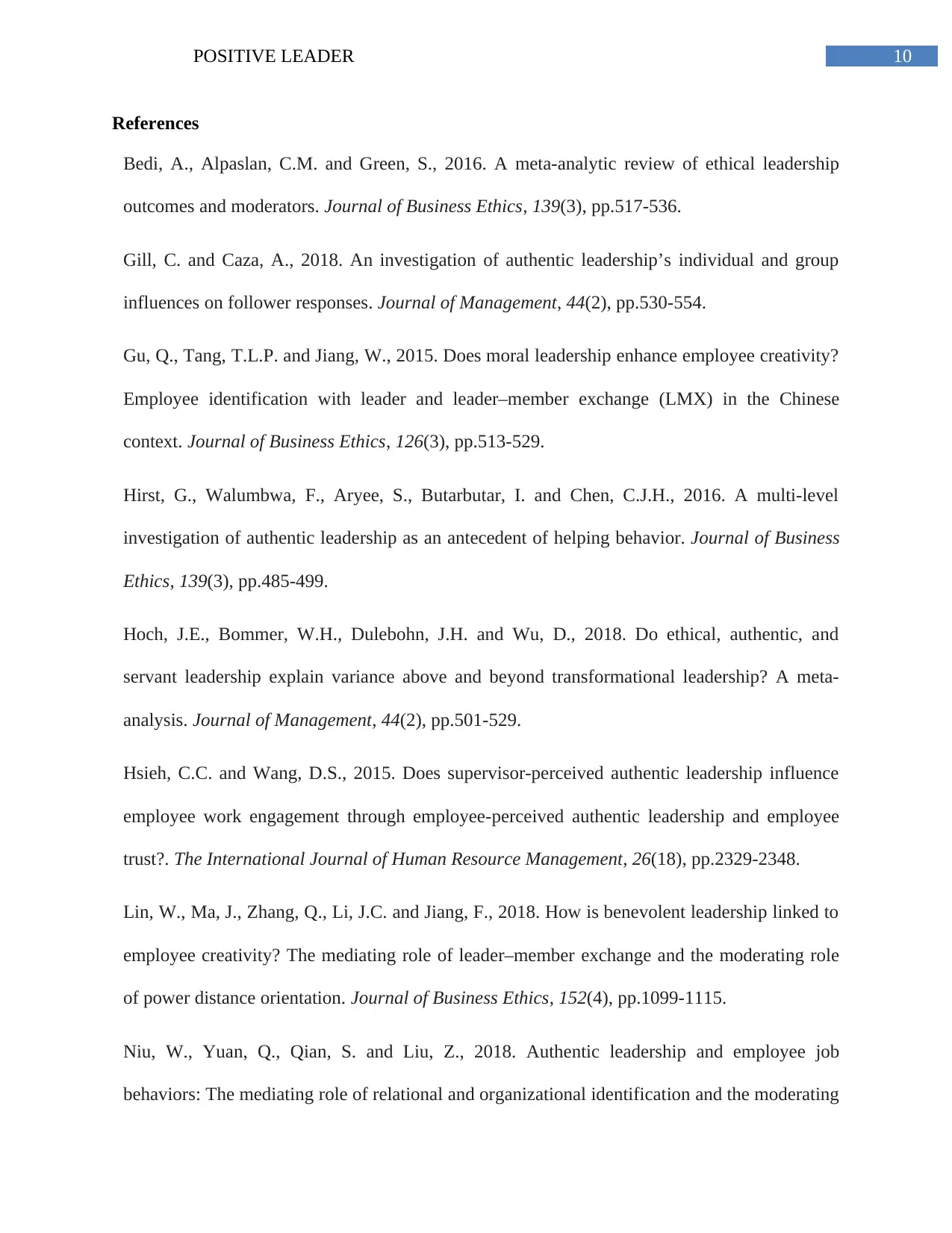
10POSITIVE LEADER
References
Bedi, A., Alpaslan, C.M. and Green, S., 2016. A meta-analytic review of ethical leadership
outcomes and moderators. Journal of Business Ethics, 139(3), pp.517-536.
Gill, C. and Caza, A., 2018. An investigation of authentic leadership’s individual and group
influences on follower responses. Journal of Management, 44(2), pp.530-554.
Gu, Q., Tang, T.L.P. and Jiang, W., 2015. Does moral leadership enhance employee creativity?
Employee identification with leader and leader–member exchange (LMX) in the Chinese
context. Journal of Business Ethics, 126(3), pp.513-529.
Hirst, G., Walumbwa, F., Aryee, S., Butarbutar, I. and Chen, C.J.H., 2016. A multi-level
investigation of authentic leadership as an antecedent of helping behavior. Journal of Business
Ethics, 139(3), pp.485-499.
Hoch, J.E., Bommer, W.H., Dulebohn, J.H. and Wu, D., 2018. Do ethical, authentic, and
servant leadership explain variance above and beyond transformational leadership? A meta-
analysis. Journal of Management, 44(2), pp.501-529.
Hsieh, C.C. and Wang, D.S., 2015. Does supervisor-perceived authentic leadership influence
employee work engagement through employee-perceived authentic leadership and employee
trust?. The International Journal of Human Resource Management, 26(18), pp.2329-2348.
Lin, W., Ma, J., Zhang, Q., Li, J.C. and Jiang, F., 2018. How is benevolent leadership linked to
employee creativity? The mediating role of leader–member exchange and the moderating role
of power distance orientation. Journal of Business Ethics, 152(4), pp.1099-1115.
Niu, W., Yuan, Q., Qian, S. and Liu, Z., 2018. Authentic leadership and employee job
behaviors: The mediating role of relational and organizational identification and the moderating
References
Bedi, A., Alpaslan, C.M. and Green, S., 2016. A meta-analytic review of ethical leadership
outcomes and moderators. Journal of Business Ethics, 139(3), pp.517-536.
Gill, C. and Caza, A., 2018. An investigation of authentic leadership’s individual and group
influences on follower responses. Journal of Management, 44(2), pp.530-554.
Gu, Q., Tang, T.L.P. and Jiang, W., 2015. Does moral leadership enhance employee creativity?
Employee identification with leader and leader–member exchange (LMX) in the Chinese
context. Journal of Business Ethics, 126(3), pp.513-529.
Hirst, G., Walumbwa, F., Aryee, S., Butarbutar, I. and Chen, C.J.H., 2016. A multi-level
investigation of authentic leadership as an antecedent of helping behavior. Journal of Business
Ethics, 139(3), pp.485-499.
Hoch, J.E., Bommer, W.H., Dulebohn, J.H. and Wu, D., 2018. Do ethical, authentic, and
servant leadership explain variance above and beyond transformational leadership? A meta-
analysis. Journal of Management, 44(2), pp.501-529.
Hsieh, C.C. and Wang, D.S., 2015. Does supervisor-perceived authentic leadership influence
employee work engagement through employee-perceived authentic leadership and employee
trust?. The International Journal of Human Resource Management, 26(18), pp.2329-2348.
Lin, W., Ma, J., Zhang, Q., Li, J.C. and Jiang, F., 2018. How is benevolent leadership linked to
employee creativity? The mediating role of leader–member exchange and the moderating role
of power distance orientation. Journal of Business Ethics, 152(4), pp.1099-1115.
Niu, W., Yuan, Q., Qian, S. and Liu, Z., 2018. Authentic leadership and employee job
behaviors: The mediating role of relational and organizational identification and the moderating
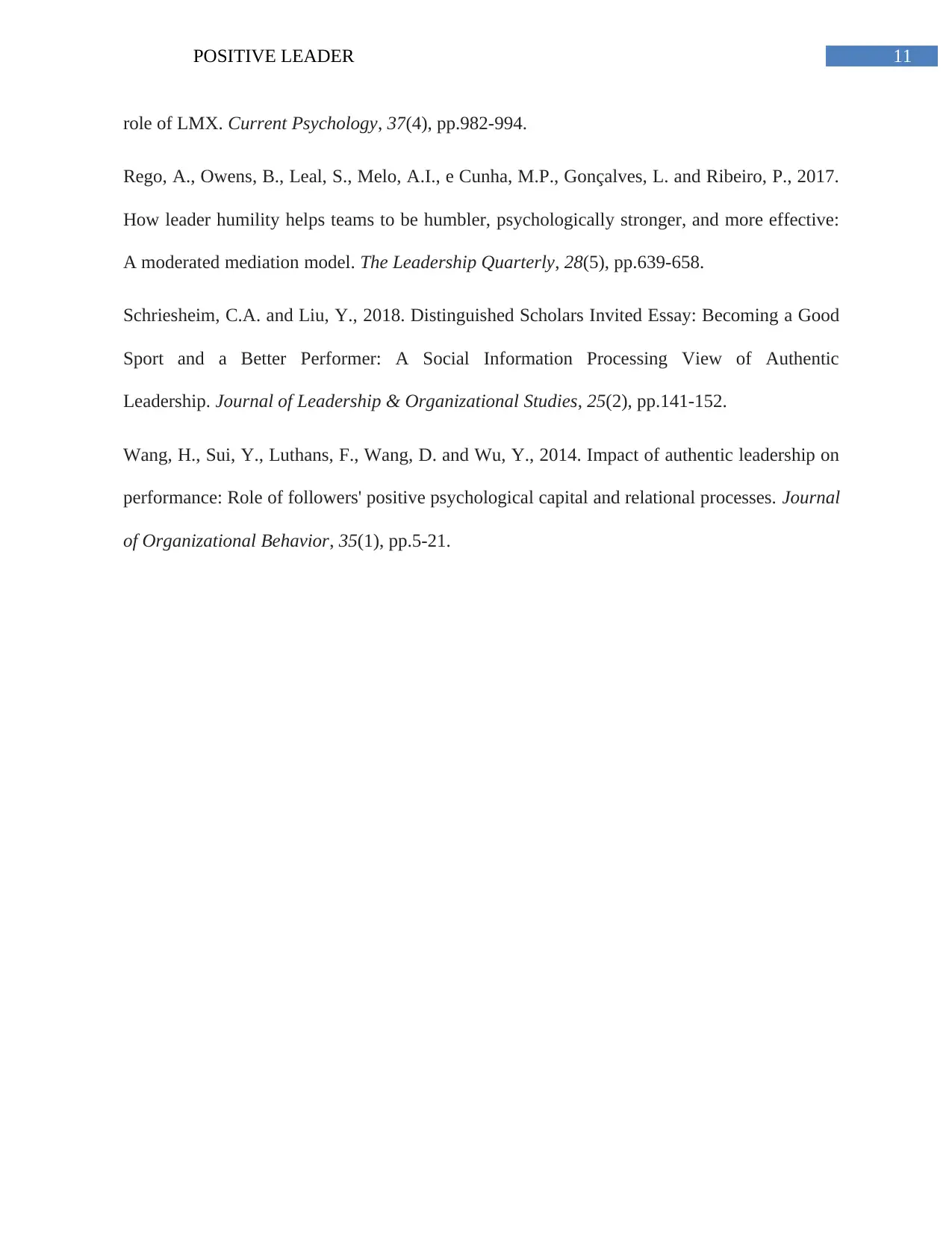
11POSITIVE LEADER
role of LMX. Current Psychology, 37(4), pp.982-994.
Rego, A., Owens, B., Leal, S., Melo, A.I., e Cunha, M.P., Gonçalves, L. and Ribeiro, P., 2017.
How leader humility helps teams to be humbler, psychologically stronger, and more effective:
A moderated mediation model. The Leadership Quarterly, 28(5), pp.639-658.
Schriesheim, C.A. and Liu, Y., 2018. Distinguished Scholars Invited Essay: Becoming a Good
Sport and a Better Performer: A Social Information Processing View of Authentic
Leadership. Journal of Leadership & Organizational Studies, 25(2), pp.141-152.
Wang, H., Sui, Y., Luthans, F., Wang, D. and Wu, Y., 2014. Impact of authentic leadership on
performance: Role of followers' positive psychological capital and relational processes. Journal
of Organizational Behavior, 35(1), pp.5-21.
role of LMX. Current Psychology, 37(4), pp.982-994.
Rego, A., Owens, B., Leal, S., Melo, A.I., e Cunha, M.P., Gonçalves, L. and Ribeiro, P., 2017.
How leader humility helps teams to be humbler, psychologically stronger, and more effective:
A moderated mediation model. The Leadership Quarterly, 28(5), pp.639-658.
Schriesheim, C.A. and Liu, Y., 2018. Distinguished Scholars Invited Essay: Becoming a Good
Sport and a Better Performer: A Social Information Processing View of Authentic
Leadership. Journal of Leadership & Organizational Studies, 25(2), pp.141-152.
Wang, H., Sui, Y., Luthans, F., Wang, D. and Wu, Y., 2014. Impact of authentic leadership on
performance: Role of followers' positive psychological capital and relational processes. Journal
of Organizational Behavior, 35(1), pp.5-21.
⊘ This is a preview!⊘
Do you want full access?
Subscribe today to unlock all pages.

Trusted by 1+ million students worldwide
1 out of 12
Related Documents
Your All-in-One AI-Powered Toolkit for Academic Success.
+13062052269
info@desklib.com
Available 24*7 on WhatsApp / Email
![[object Object]](/_next/static/media/star-bottom.7253800d.svg)
Unlock your academic potential
Copyright © 2020–2025 A2Z Services. All Rights Reserved. Developed and managed by ZUCOL.




